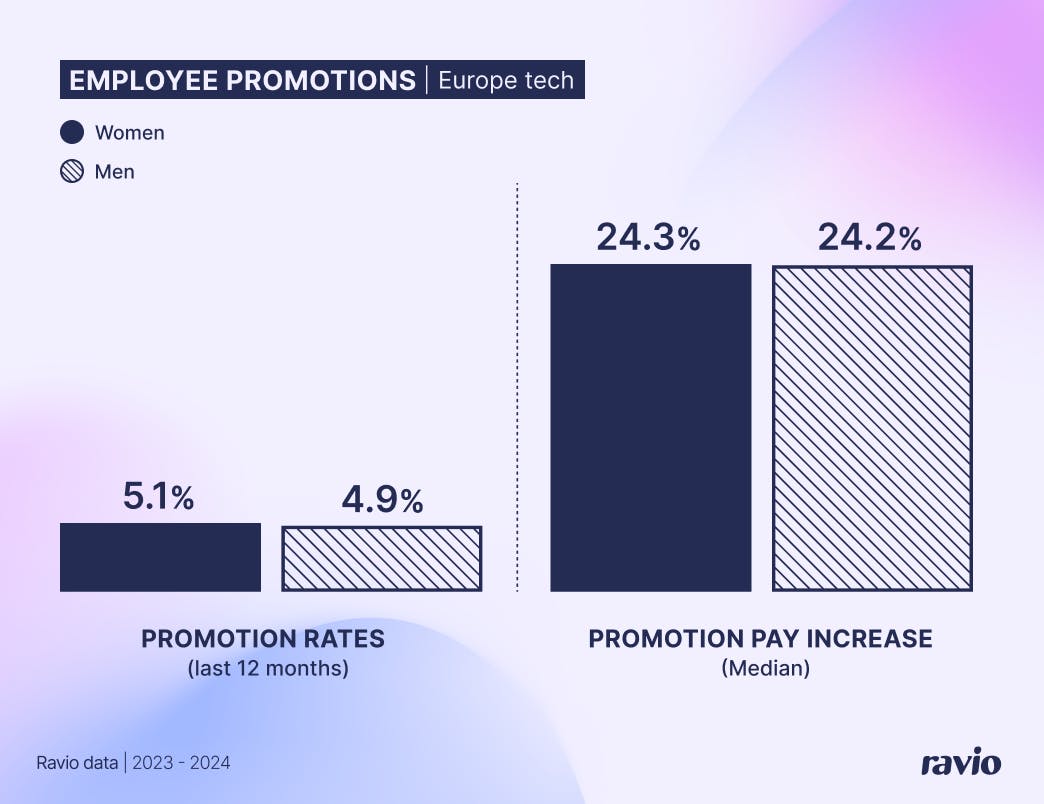Despite growing awareness and regulatory pressure from the EU Pay Transparency Directive, the gender pay gap continues across all major tech markets in Europe.
Ravio's 2026 Compensation Trends Report analysed salary data from European tech companies to understand the current state of gender pay equality.
The findings reveal a 23% unadjusted gender pay gap and 2.4% adjusted gender pay gap across Europe in 2025 – with significant variation across countries and underlying structural issues that extend beyond simple pay discrimination.
What is the gender pay gap in 2025?
The gender pay gap in Europe stands at 23% (unadjusted) and 2.4% (adjusted) in 2025 – from Ravio’s 2026 Compensation Trends report.
These two measures tell different but complementary stories about pay inequality:
- The unadjusted gender pay gap compares median earnings between all men and all women without accounting for factors like role, seniority, or location. At 23%, this reveals the raw difference in what men and women earn across Europe.
- The adjusted gender pay gap provides a like-for-like comparison between men and women, accounting for factors like the same role at the same level in the same location. At 2.4%, this measures whether women are paid less than men for genuinely equal work.
The significant gap between these figures reinforces that the representation of women in the workforce remains the core challenge for pay equity.
Women are underrepresented in senior, higher-paying positions rather than being systematically underpaid for identical roles, and it's this structural imbalance that drives the larger unadjusted gap.
"Efficiency and profitability are still dominating the executive agenda, and whilst HR teams know they need to prioritise pay transparency, they're also waiting to see how their countries will translate the EU Directive into local law. But what companies should be hyper-conscious of is that the next compensation review (likely Q1 2026 for most) will be their last chance to fix pay gaps through the normal cycle before transparency requirements come into effect."

Senior Compensation Manager at Bolt and Co-founder of Cohorts
How does the gender pay gap vary across Europe?
The gender pay gap varies significantly across European markets:
- UK gender pay gap 2025: The UK has one of the highest unadjusted gender pay gaps in Europe in 2025 at 28%, but one of the lowest adjusted gaps at 2.0%.
- Germany gender pay gap 2025: Germany sits close to the European average with an unadjusted gender pay gap of 23% and an adjusted gap of 2.1%.
- Netherlands gender pay gap 2025: The Netherlands presents an interesting case. Whilst it has one of the lowest unadjusted gender pay gaps in Europe at 21%, it has the highest adjusted gap at 4.0%. This suggests that Dutch tech companies have better representation of women across seniority levels, but there may be greater bias in how compensation decisions are made for equal roles.
- France gender pay gap 2025: France shows a similar pattern to the Netherlands, with a relatively low unadjusted gap of 19% but a high adjusted gap of 3.9%.
- Spain gender pay gap 2025: Spain has the highest unadjusted gender pay gap across Europe at 30%, yet one of the lowest adjusted gaps at 1.9%.
- Sweden gender pay gap 2025: Sweden has the lowest unadjusted gender pay gap in Europe at 17%, but a more moderate adjusted gap of 2.5%.
What causes the gender pay gap?
There are many structural reasons that drive the gender pay gap – but three key patterns emerge in the European tech sector: representation, hiring practices, and the broader structural challenges women face balancing careers with caregiving responsibilities.
Cause #1: Women are underrepresented in senior positions
The biggest driver of the gender pay gap is representation.
Women make up just 40% of the European tech workforce overall, and – most significantly – hold just 21% of executive roles.
This dramatic drop-off at senior levels drives up the unadjusted pay gap, creating a structural imbalance where fewer women have access to the highest-paying roles in tech. With more men earning higher salaries in leadership positions, the overall earnings gap between genders widens significantly.
"I'm seeing companies publishing their data and checking the compliance box, but not addressing root causes. Transparency alone doesn't fix systematic pay equity issues – it's the promotion patterns, role levelling inconsistencies, negotiation biases, and so on that we need to look deeper into."

Director at FNDN
Cause #2: Pay gaps are introduced at the point of hire
Ravio’s pay equity analysis found that men and women have similar rates of promotion (around 7-8%) and pay increases (around 23%).
Therefore, gender pay inequality must exist from the start of employment – rather than being introduced as employees progress.
This points to issues in hiring practices rather than bias in internal progression, with factors like recruiting bias and salary negotiation impacting the starting salary that men and women receive for equal work.
Cause #3: Women still bear disproportionate caregiving responsibilities
Women continue to shoulder more unpaid care work than men, which impacts their career trajectories.
Research shows that mothers are much more likely than fathers to reduce working hours or withdraw from full-time employment after having children, creating career interruptions that compound over time into significant differences in pay.
Whilst tech companies often offer more progressive parental leave policies than traditional sectors, the structural challenge remains: women are more likely to take extended time away from work and to manage ongoing caregiving responsibilities alongside their careers, which can limit progression opportunities into more senior, higher-paying roles.
FAQs
What is the gender pay gap?
The gender pay gap is the difference in earnings between men and women. The unadjusted gender pay gap compares all men and women regardless of role or seniority, whilst the adjusted gender pay gap compares men and women in the same role at the same level.
How do you calculate the gender pay gap?
The unadjusted gender pay gap is calculated by comparing median earnings between all men and all women. The adjusted gender pay gap uses regression analysis to account for factors like location, job function, and seniority level, enabling a like-for-like comparison of equal pay for equal work.
How big is the gender pay gap?
In 2025, the gender pay gap in Europe stands at 23% (unadjusted) and 2.4% (adjusted for factors like role, level, location).
The UK has the highest unadjusted gap at 28%, whilst Sweden has the lowest at 17%. For adjusted gaps, the Netherlands (4.0%) and France (3.9%) have the highest, whilst Spain (1.9%) and the UK (2.0%) have the lowest.
Why is there a gender pay gap?
A major driver behind the gender pay gap is the underrepresentation of women in senior positions – women hold just 21% of executive roles in European tech despite making up 40% of the workforce. Pay gaps are also introduced at the point of hire through bias in compensation decisions, and women's disproportionate caregiving responsibilities can limit career progression into higher-paying roles.
Is the gender pay gap real?
Yes. Ravio’s data shows a persistent 23% unadjusted gender pay gap and 2.4% adjusted gender pay gap in Europe in 2025. Whilst the gap between these figures reveals that representation is the primary driver rather than unequal pay for identical work, both measures demonstrate that women earn less than men across the industry.
Is there a gender pay gap in the UK?
Yes. The UK has a 28% unadjusted gender pay gap and 2.0% adjusted gender pay gap in 2025 (Ravio 2026 Compensation Trends report).
Whilst the UK has one of the lowest adjusted gaps in Europe, suggesting relatively equitable pay for equal roles, it has one of the highest unadjusted gaps due to poor representation of women in senior positions – women hold just 24% of executive roles in the UK.
How can we close the gender pay gap?
Closing the gender pay gap requires addressing three key areas: improving representation of women in senior positions through targeted hiring and promotion practices, eliminating bias in compensation decisions at the point of hire by using objective data and removing salary history questions, and providing better support for working parents to ensure caregiving responsibilities don't limit career progression.








